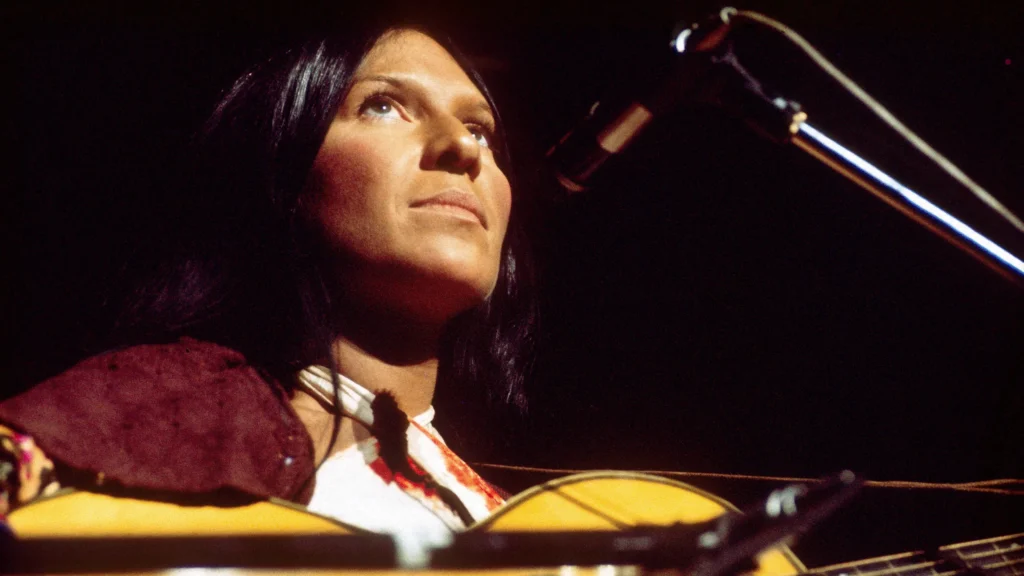Buffy Sainte-Marie, a trailblazing singer-songwriter and activist, has carved out a distinctive niche in the music world over her six-decade-long career. Starting as a folk musician in the 1960s, she quickly gained recognition for her poignant lyrics and powerful voice, becoming a prominent figure in the genre. However, Sainte-Marie’s artistic journey didn’t stop there; she continually reinvented her sound, exploring a wide range of musical styles, from folk to rock, country, and ultimately, electronic music.
Her evolution as an artist reflects not only her versatility but also her commitment to pushing musical boundaries. Sainte-Marie’s willingness to experiment with different genres and technologies has resulted in a rich and varied discography that defies easy categorization. Her integration of electronic elements into her music, particularly in the 1980s and beyond, showcased her forward-thinking approach and influenced subsequent generations of musicians.
Early Life and Musical Beginnings

Buffy Sainte-Marie was born on the Piapot Cree First Nation Reserve in Saskatchewan, Canada, in 1941. Adopted by a part-Mi’kmaq family and raised in Massachusetts, she grew up in a culturally diverse environment that deeply influenced her musical journey. From an early age, Sainte-Marie was drawn to music, teaching herself to play the piano and guitar. Her exposure to traditional Indigenous music, combined with her love for American folk and pop, shaped her unique sound.
Sainte-Marie’s first forays into folk music began during her college years at the University of Massachusetts Amherst, where she studied Oriental philosophy and education. She started performing at coffeehouses and small venues, quickly gaining a reputation for her distinctive voice and emotionally charged songwriting. Her music often tackled themes of love, war, and social justice, setting her apart from her contemporaries.
In 1964, Sainte-Marie released her debut album, “It’s My Way!,” which featured the iconic protest song “Universal Soldier.” The album was a critical success, earning her a place among the leading voices of the 1960s folk revival. Her poignant lyrics and passionate performances resonated with audiences, and she soon became a prominent figure in the folk scene, performing at major festivals and collaborating with other influential artists.
Folk Music Era

Buffy Sainte-Marie’s folk music era in the 1960s was marked by a series of influential albums and songs that cemented her place in the folk music pantheon. Her debut album, “It’s My Way!” (1964), introduced the world to her distinct voice and poignant songwriting. This album included the iconic anti-war anthem “Universal Soldier,” which became a defining protest song of the era. Following this, her albums “Many a Mile” (1965) and “Little Wheel Spin and Spin” (1966) continued to build her reputation, featuring songs like “Cod’ine,” “My Country ‘Tis of Thy People You’re Dying,” and “Until It’s Time for You to Go.”
Themes and Lyrical Content
Sainte-Marie’s folk period was characterized by her incisive lyrics and willingness to address a range of complex and often controversial themes. Her songs delved into issues such as war, peace, love, and heartbreak, but they were also deeply political. “Universal Soldier” critiqued the individual responsibility in perpetuating war, while “My Country ‘Tis of Thy People You’re Dying” confronted the systemic oppression and cultural genocide of Indigenous peoples in North America. Her lyrical content was unflinching and direct, reflecting her activism and commitment to social justice.
Influence on and Contributions to the Folk Music Community
Buffy Sainte-Marie’s contributions to the folk music community were profound. Her music not only entertained but also educated and inspired listeners to think critically about social issues. She brought Indigenous perspectives to a predominantly white folk scene, broadening the genre’s horizons and paving the way for future generations of Indigenous artists. Her powerful storytelling and distinctive voice influenced her peers and successors alike, including artists such as Joni Mitchell and Joan Baez.
Moreover, Sainte-Marie’s presence in the folk community helped to challenge and expand the genre’s boundaries. By incorporating elements of Indigenous music and addressing topics that were often ignored by mainstream artists, she enriched the folk tradition with new sounds and ideas. Her work during this era remains a testament to the power of music as a tool for cultural expression and social change.
Transition to Diverse Musical Styles

Reasons for Branching Out from Folk
Buffy Sainte-Marie’s decision to branch out from folk music was driven by her relentless curiosity and desire to explore new artistic territories. While she was already a prominent figure in the folk scene, she felt constrained by the genre’s traditional boundaries and sought to break free from its limitations. Sainte-Marie’s innovative spirit and willingness to experiment with different sounds and technologies led her to explore other musical styles, allowing her to express her creativity more fully and connect with a broader audience.
Introduction of New Instruments and Sounds
As Sainte-Marie transitioned away from pure folk music, she began to incorporate a variety of new instruments and sounds into her work. One of her most significant innovations was her use of electronic instruments, which was groundbreaking for the time. In the 1969 album “Illuminations,” she utilized a Buchla synthesizer, making it one of the first albums to feature synthesizer technology prominently. This marked a radical departure from the acoustic instrumentation typical of folk music and showcased her willingness to embrace emerging technologies.
In addition to electronic instruments, Sainte-Marie also integrated elements of rock, country, and Indigenous music into her songs. She experimented with electric guitars, orchestral arrangements, and traditional Indigenous drums and chants, creating a rich tapestry of sound that defied easy categorization. This eclectic approach allowed her to push the boundaries of her music and create a unique auditory experience.
First Experiments with Non-Folk Genres
Sainte-Marie’s initial experiments with non-folk genres can be heard in several key projects. Her 1971 album “She Used to Wanna Be a Ballerina” featured a more rock-oriented sound, with contributions from renowned artists like Neil Young and Crazy Horse. This album blended rock, folk, and country influences, highlighting her versatility as an artist.
Her 1974 album “Buffy” continued this trend, incorporating elements of pop and jazz. Songs like “Sweet Little Vera” and “I Can’t Take It No More” demonstrated her ability to navigate different musical landscapes while maintaining her distinctive voice and message. Sainte-Marie’s willingness to explore various genres not only broadened her artistic horizons but also paved the way for future musicians to experiment with genre-blending in their own work.
Embracing Electronic Music

Key Projects and Albums Featuring Electronic Elements
Buffy Sainte-Marie’s foray into electronic music marked a significant evolution in her sound and showcased her pioneering spirit. One of the most notable projects in this regard was her 1969 album “Illuminations.” This album was groundbreaking as it was one of the first to use a Buchla synthesizer, an early and complex electronic instrument. “Illuminations” blended folk roots with experimental electronic sounds, creating a unique and avant-garde listening experience that was ahead of its time.
In the 1980s, Sainte-Marie continued to explore electronic music with her album “Coincidence and Likely Stories” (1992). Recorded in her home studio and using computers and synthesizers, this album demonstrated her continued interest in and mastery of electronic soundscapes. It included tracks like “Starwalker” and “Fallen Angels,” which featured rich electronic arrangements and production techniques that added depth and complexity to her music.
Notable Songs and Their Impact
“God Is Alive Magic Is Afoot” from “Illuminations” is a standout track that epitomizes Sainte-Marie’s innovative use of electronic music. The song, based on a poem by Leonard Cohen, merges her haunting vocals with the eerie, otherworldly sounds of the Buchla synthesizer. This track not only expanded the possibilities of folk music but also influenced the broader music landscape by demonstrating how electronic elements could be integrated into traditional genres.
“Up Where We Belong,” co-written by Sainte-Marie for the 1982 film “An Officer and a Gentleman,” won an Academy Award for Best Original Song. While not purely electronic, the song’s production incorporated synthesizers and modern studio techniques, showcasing her ability to blend electronic elements with mainstream pop sensibilities. The success of this song brought electronic music influences into the mainstream and highlighted Sainte-Marie’s versatility as a songwriter and producer.
Collaborations with Electronic Music Producers and Artists
Buffy Sainte-Marie’s embrace of electronic music also led to collaborations with various producers and artists in the field. For instance, on “Coincidence and Likely Stories,” she worked with producer Chris Birkett, who helped bring a polished electronic sound to the album. Their collaboration resulted in a seamless integration of digital and analog elements, furthering Sainte-Marie’s innovative approach to music production.
Additionally, Sainte-Marie’s influence extended to her work with other artists who were inspired by her electronic experimentation. Her willingness to collaborate and incorporate new technologies into her music served as an inspiration for many musicians exploring the intersection of folk and electronic music.
Cultural and Political Impact

How Her Diverse Sound Reflects Her Activism
Buffy Sainte-Marie’s diverse sound is deeply intertwined with her activism, reflecting her commitment to social justice and Indigenous rights. Her eclectic musical style, which spans folk, rock, electronic, and more, mirrors her belief in breaking boundaries and challenging the status quo. Sainte-Marie’s music often serves as a vehicle for her activism, addressing issues such as war, environmentalism, and Indigenous struggles. By incorporating a wide range of sounds and influences, she broadens the appeal of her messages, reaching diverse audiences and fostering greater awareness and understanding.
Contributions to Indigenous Rights and Representation in Music
Sainte-Marie has been a tireless advocate for Indigenous rights throughout her career. Her songs frequently highlight the experiences and struggles of Indigenous peoples, bringing their stories to the forefront of popular music. Tracks like “My Country ‘Tis of Thy People You’re Dying” offer a searing critique of colonialism and the systemic oppression of Indigenous communities, providing a powerful platform for these issues.
Beyond her music, Sainte-Marie has actively worked to support Indigenous representation in the arts. She was instrumental in creating the Nihewan Foundation for Native American Education, which aims to provide educational opportunities for Indigenous youth. Additionally, her involvement in Sesame Street during the 1970s and 1980s helped bring Indigenous culture and issues to mainstream media, educating a broad audience and fostering greater cultural understanding.
Reception of Her Politically Charged Songs Across Different Genres
Sainte-Marie’s politically charged songs have been received with both acclaim and controversy across various genres. In the folk music community, her direct and poignant lyrics have been celebrated for their bravery and relevance. Songs like “Universal Soldier” became anthems for the anti-war movement, resonating deeply with the countercultural ethos of the 1960s and beyond.
In the realm of electronic music, her album “Illuminations” was ahead of its time, blending political commentary with innovative soundscapes. While it initially puzzled some listeners and critics, it has since been recognized as a groundbreaking work that challenged conventional music boundaries.
Her crossover into mainstream pop with “Up Where We Belong” showcased her ability to infuse popular music with deeper messages. The song’s success demonstrated that politically conscious music could achieve commercial success, influencing a new wave of artists to incorporate social and political themes into their work.
Legacy and Influence

How Her Eclectic Sound Has Influenced Other Artists
Buffy Sainte-Marie’s eclectic sound has left an indelible mark on multiple generations of artists across various genres. Her pioneering use of electronic elements in folk music, exemplified by the album “Illuminations,” opened new possibilities for musicians interested in blending traditional and modern sounds. Artists such as Joni Mitchell, who also pushed the boundaries of folk, have cited Sainte-Marie as an influence. Additionally, her fearless approach to integrating political and social commentary into her music has inspired countless singer-songwriters to use their art as a platform for activism.
Sainte-Marie’s influence extends to Indigenous artists, who see her as a trailblazer in bringing Indigenous perspectives to a broader audience. Contemporary Indigenous musicians, such as Tanya Tagaq and A Tribe Called Red, have drawn inspiration from Sainte-Marie’s fusion of cultural heritage with innovative musical styles, continuing her legacy of artistic and activist excellence.
Recognition and Awards
Buffy Sainte-Marie’s contributions to music and activism have been widely recognized and celebrated. She has received numerous awards and honors throughout her career, reflecting her significant impact on the music industry and beyond. Notable accolades include:
Academy Award: Best Original Song for “Up Where We Belong” (1982), co-written for the film “An Officer and a Gentleman.”
Juno Awards: Multiple Juno Awards, including Indigenous Album of the Year and Best Music of Aboriginal Canada Recording.
Polaris Music Prize: Longlisted for her album “Power in the Blood” (2015), which also won the Juno Award for Aboriginal Album of the Year.
Order of Canada: One of Canada’s highest civilian honors, awarded for her outstanding contributions to music and her advocacy for Indigenous rights.
These awards are a testament to her artistic excellence and her dedication to using her platform for positive social change.
Her Place in Music History
Buffy Sainte-Marie occupies a unique and revered place in music history. As a pioneering artist who seamlessly blended folk, rock, electronic, and Indigenous music, she has expanded the boundaries of what is possible in the musical landscape. Her willingness to innovate and address difficult subjects through her music has earned her a reputation as one of the most courageous and influential musicians of her time.
Sainte-Marie’s impact extends beyond her musical innovations; she is also a vital cultural figure who has championed Indigenous rights and brought attention to social injustices through her art. Her legacy is one of fearless creativity, activism, and unwavering commitment to truth and justice.
